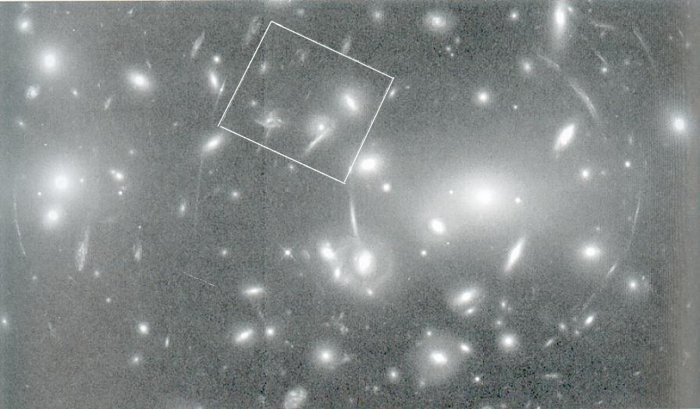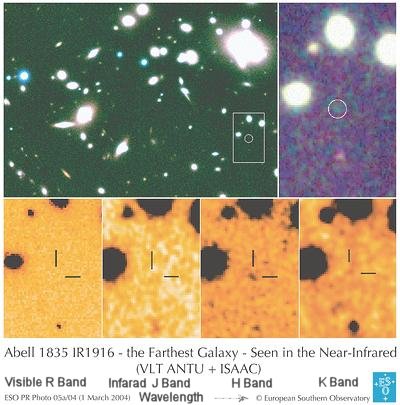

| Home Page | Overview | Site Map | Index | Appendix | Illustration | About | Contact | Update | FAQ |
 |
 |
Bending of light is one of the many applications under the theory of general relativity. The Sun deflects star light behind by a small fraction of 1.75" as confirmed by Sir Arthur Eddington's 1919 solar eclipse expeditions. Since the amount of deflection is proportional to the mass of the lensing object, it was suggested back in 1937 that entire galaxies, or even clusters of galaxies could act as giant magnifying lenses in space (Figure 04-07a). Observational difficulty prevented such detection until 1972 when identical quasar images were spotted at both radio and optical wavelength for QSO 0957, which is 5 billion light years behind the intervening giant elliptical galaxy YGKOW G1 (at a distance of 3.7 billion light years from |
Figure 04-07a Gravita- tional Lens |
Figure 04-07b QSO0957 + 561a, b [view large image] |
here, see Figure 04-07b). Gravitational lensing can also be used to estimate the rate of cosmic expansion (via light variation from quasar), and it would yield information about dark matter if the bending cannot be accounted for by the visible (lensing) matter alone. |
 |
As shown in Figure 04-07a (illustration at the bottom) when light from a background source, such as a galaxy, passes through the gravitational field of a foreground cluster, it is also deflected by its gravitational field. If the alignment is right, an image of the back-ground object will be produced. The image would be larger and brighter than the object would appear without the "lens". If the source, lens, and observer are lined up along a straight line, a distant point of light will be spread out into a ring called an "Einstein ring", whereas if the alignment is imperfect the background source will be seen as two or more arc-shaped images. An example of this pheno-menon is shown in Figure 04-07c. This is the cluster A2218, which has produced more than 120 arc-shaped images of |
Figure 04-07c Einstein Ring, Abell 2218; |
galaxies that are members of a remote cluster. Analyses of the lensing effects produced by clusters have confirmed that clusters of galaxies contain from ten to one hundred times as much dark matter as |
 |
 |
luminous matter. The gravitational lensing of Abell 2218 has revealed a galaxy with redshift of 6.6 - 7.1 corresponding to a look back time of about 13x109 years (750 million years after the Big Bang or 5% the age of the universe). It is among the most distant objects ever observed as shown in Figure 04-08 in the form of a pair of faint red arcs (also see ERO - Extremely Red Object). A March, 2004 report indicates a galaxy still further away at a distance of 13.23x109 lys with a size less than 300 lys across (see Figure 04-09). |
Figure 04-08 Lensing [view large image] |
Figure 04-09 Ancient Galaxy |